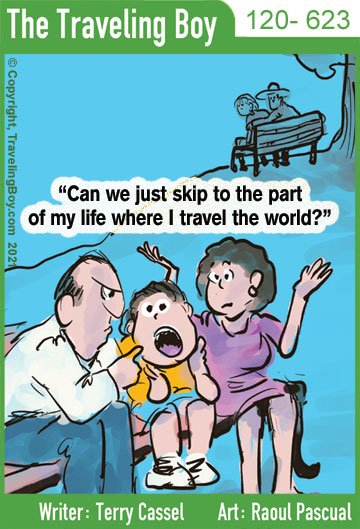
This Is the Most Punctual Airline in the U.S. – for the 18th Year Running

Hawaiian Airlines continues to live up to its reputation for timeliness as the U.S. Department of Transportation (DOT) has named it most punctual for the 18th year.
According to data released by the DOT last month, the carrier was on time for 90.14% of its 60,654 flights operated in 2021, making it the number one American airline for punctuality.
This Country Was Just Named Happiest in the World
By Rachel Chang

Every year for the past decade, the World Happiness Report ranks how people in more than 150 countries evaluate the quality of their lives to find the world’s happiest countries. And for the past four years, the top spot has been claimed by Finland.
MORE about Happiest CountryToday, the Sustainable Development Solutions Network, which publishes the report together with Gallup World Poll, announced that the Nordic country is yet again leading the list.
Generosity, perception of compassion, freedom to make life choices, social support, and life expectancy are some of the factors evaluated when determining the rankings, with each country scoring on a 10-point scale.
Finland was named the happiest country in the world with a score of 7.821 out of 10 ahead of Denmark (7.636) and Iceland (7.557), which came in second and third, respectively. The United States came in 16th place, up three spots from last year.
ROBERT MATZEN
Author of “WARRIOR: AUDREY HEPBURN” on Our City Tonight

The 10 Best Cities in the World for Art Lovers
Courtesy of Jessica Poitevien
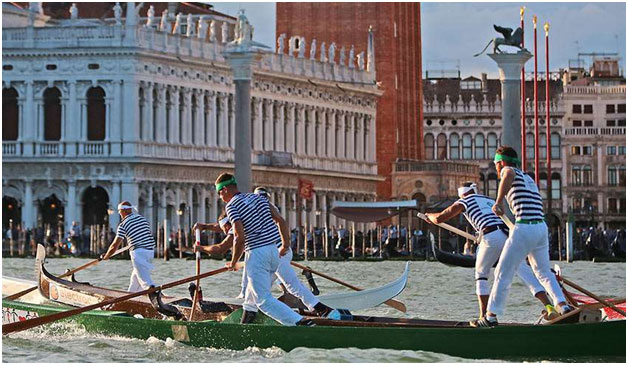
For art aficionados looking to plan their next trip, the resident experts at Money.co.uk conducted a study to find the best art and culture-filled cities around the world. The study used a variety of data points to rank 40 global cities already known for their unique arts and culture scenes.
Ranking criteria included more obvious factors, like the number of galleries, museums, and sculptures, but also took into account variables such as street art and highly rated art universities and colleges to give a more complete picture of each city’s offerings.
Topping the list is Venice with a survey score of 6.81 out of 10. The canal-filled city is a designated UNESCO World Heritage Site thanks to its lagoon and culturally significant architecture. Beyond the impressive architecture, Venice had the highest marks among the top 10 cities for its number of monuments and statues (94 per million people), as well as museums (183.3 per million people).
Coming in second place is Miami, a city once known only for its beaches and wild nightlife. Recent years have seen a boom in Miami’s art scene with no end in sight. The city took the No. 2 slot by achieving top marks in three categories: number of galleries (113.1 per million people), street art searches (30,391 per million people), and street art Instagram posts (130,949 per million people).
Rounding out the top three is another Italian favorite: Florence. This Tuscan city is full of examples of Renaissance art and architecture, and it ranked particularly well for its number of museums: 204.5 per million people.
Overall, U.S. cities dominated the rankings with San Francisco (No. 5), Sante Fe (No. 7) and Seattle (No. 8) also ranking in the top eight best cities for art and culture lovers. Europe also made a strong showing with Austria coming in fourth place, followed by Berlin in ninth, and Milan in 10th.
For more details on these rankings and to see what other cities made the larger top 40 list, head to Money.co.uk.
When did women swap skirts for trousers?
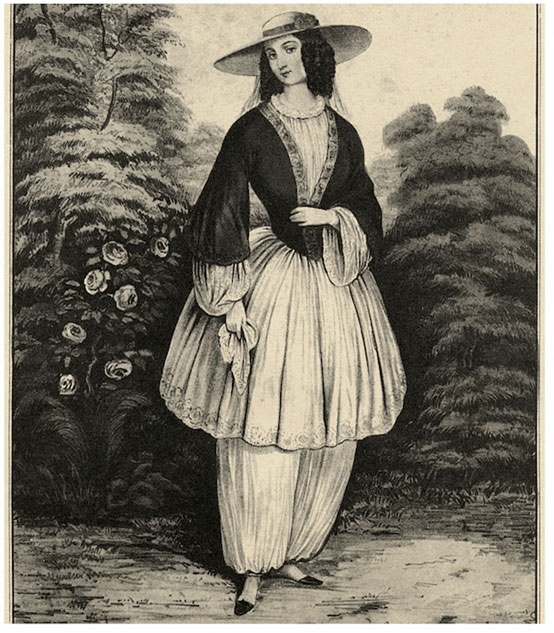
When did women start wearing trousers? The short answer is in prehistory, and there have been many civilizations throughout human history that have survived the ‘scandal’ of its women wearing trouser-like garments.
MORE ON Swap SkirtsOf course, there are plenty of societies that found it harder, many of them in the west. Let’s not forget, the idiom ‘who wears the trousers?’ is still commonplace.
It had been custom, even law, for women to wear dresses or skirts for centuries – one of the charges levied at Joan of Arc on her way to the stake in 1431 was cross dressing – and this norm was only seriously challenged in the mid-19th century.
American campaigner for dress reform and women’s rights Elizabeth Smith Miller designed a type of trouser in the early 1850s. Her ‘Turkish dress’ was a skirt to the knees with puffy trouser legs to the ankles. The outfit caught on after being advertised in The Lily, a magazine owned by American womens’ rights activist Amelia Jenks Bloomer – which is why they quickly became known as bloomers.
Change was slow, so much so that it was big news every time Hollywood A-listers Marlene Dietrich and Katharine Hepburn wore trousers in the 1930s. It was more than a century after the bloomer era before the trouser designs and miniskirts of the 1960s significantly changed attitudes of what women wore on their legs. About blooming time, but let’s not forget the idiom ‘who wears the trousers?’ is still commonplace.
This article was taken from issue 71 of BBC History revealed.
The 5 Most Popular Arts and Crafts Museums in America
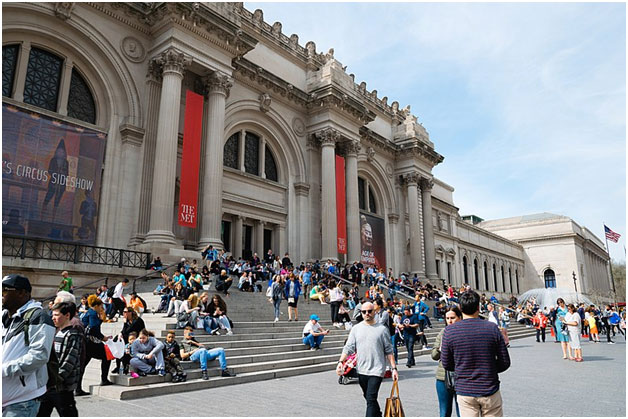
The Metropolitan Museum of Art in New York has been revealed as the most popular craft museum in the United States,according to a new study by Design Bundles. Often shortened to the MET, comes on top, with a total of 368,000 monthly searches and 406,170 Instagram hashtags. One of the most popular landmarks in New York, primarily famous for events like the MET Gala and its exhibitions, holds numerous craft pieces, with mediums spanning clay, fiber, glass, metal, and wood.
MORE ON Arts and Crafts Museums
Second on the list is the Philadelphia Museum of Art, in Pennsylvania, with 60,500 average monthly searches and 81,085 hashtags. The museum is one of the largest in the country, with a collection that counts more than 240,000 pieces and almost 800,000 visitors each year. The most prominent mediums for the pieces hosted by the museum are clay, fiber, glass, metal, and wood.
In third comes San Francisco’s de Young Museum, which was established in 1895 and receives an estimated average of 33,100 monthly searches. Its hashtag has been used in 91,914 Instagram posts, the second-highest number of hashtags on the list. The museum hosts pieces from multiple cultures and ethnicities, with collections that span from the “Arts of the Americas” to “African Art”, “Oceanic Arts”, and “Textile Arts”.
The Denver Art Museum in Colorado comes in fourth, with 40,500 monthly searches and 77,668 posts featuring the museum’s name hashtag. The museum, also known as DAM, is one of the largest on the West Coast and is mostly known for its Native American art exhibition and The Petrie Institute of Western American Arts.
The top five closes with The Museum of Modern Art, better known as MoMA, with almost 50 thousand average monthly searches and 63,232 Instagram hashtags reporting its full name. Situated in the heart of New York, the MoMA hosts one of the most significant art collections globally, including 1889 Starry Night by Vincent Van Gogh and 1928 The Lovers by René Magritte. The museum is also home to numerous sculptures and craft pieces made from fiber, clay, and glass.
STRONG WOMEN IN ENGLISH LANGUAGE CINEMA
Sally Field, Norma Rae (1979)
Audrey Hepburn, The Nun’s Story (1959)
Joan Crawford & Mercedes McCambridge, Johnny Guitar (1954)
Marlene Dietrich, The Scarlett Empress (1934)
Whoopi Goldberg & Oprah Winfrey, The Color Purple (1985)
Lupita Nyong’o, 12 Years a Slave (2013)
Julia Roberts, Erin Brockovich (2000)
Barbara Stanwyck, Forty Guns (1957)
Meryl Streep, Silkwood (1983)
Hilary Swank, Million Dollar Baby (2004)
Emily Watson, Breaking the Waves (1996)
Courtesy of the T-Boy Society of Film, Travel & Music
The Origins of 12 Caribbean Music Styles
Cha Cha Dance Lesson for Beginners
From reggaetón to the cha-cha-cha to the “singing newspapers” known as plena, Caribbean and Latin American musical genres have interesting origin stories and collaboration, across countries and cultures, is always key to their creation.
Let’s travel around the Caribbean for a tour of the names and origins of some of these musical styles.
Listen to more Caribbean MusicReggaetón
Bad Bunny is one of the most streamed artists in the world, meaning he’s taken the genre known as reggaetón far beyond the countries of Puerto Rico and Panama, where it originated. The word reggaetón was first recorded in English in the early 2000s, and it’s basically a combination of reggae (a name that originated in the genre’s birthplace, Jamaica) and the ending -tón, the Spanish version of -athon used in words like marathon (or maratón). Reggae has long been popular throughout all of the Caribbean, and in the 1990s, various artists created the blend now known as reggaetón, which combines Spanish rap lyrics with a vigorous percussive beat for dancing.
Notable artists: Bad Bunny, Ozuna, and Daddy Yankee (Puerto Rico); J Balvin and Karol G (Colombia).
Cumbia
While the worldwide popularity of reggaetón is a relatively recent phenomenon, many of the words used today to refer to Caribbean music date back hundreds of years. That’s the case with cumbia, “a dance music of Colombian origin, similar to salsa and using guitars, accordions, bass guitar, and percussion.” Colombia has a coastline on the Caribbean Sea, across from Cuba and Puerto Rico, a proximity that led these places to influence each other musically.
The word cumbia was first recorded in English in the 1860s, but its origin is uncertain. Some lexicographers believe it comes from Africa, via the Bantu people, noting that the African words cumbé (“dance/rhythm”) and kumba (“noise/shouting”) could have musical meanings. African cultural influences in the Caribbean and South America trace back to the estimated 5 million African people who were enslaved and forcibly brought to these regions by European colonizers from the 1600s to 1800s. Their descendants are now spread throughout the Caribbean and Latin American countries, and many identify as Black, biracial, or triracial.
Notable artists: Los Corraleros de Majagual, La Sonora Dinamita, Totó La Momposina (Colombia). The musical genre crossed over into Mexico in the 1940s, inspiring such artists as Selena (sometimes known as the “Cumbia Queen”).
Bachata
Bachata, “a Latin American musical genre in the style of a ballad, featuring guitars, percussion, and singing,” originated in the Dominican Republic. The word bachata is believed to have been first recorded in Spanish in the 1920s from West African origins (possibly an abbreviation of cumbancha, which is also related to cumbé). Because of its poignant, often heartbreaking lyrics, this type of music was originally known as amargue (“bitterness” or “bitter music”).
Notable artists: José Manuel Calderón, Marino Perez, Leonardo Paniagua, Luis Vargas, and YoskarSarante (Dominican Republic).
Merengue
The word merengue-the name of both a dance and the music for it-was first recorded in Puerto Rico and the Dominican Republic in the 1840s. The name shares a connection with Krio maringa, the Jamaican Creole merengue, and Haitian Creole mereng. There may be a relation to the dessert meringue (which is typically made from a mixture of egg whites and sugar). The connection to the confection is unclear, but it may be a reference to the idea that the dance is a “mixture” or due to its quick, rhythmic steps (like whipping up a dessert). Merengue is known for its romantic themes and is based on a five-beat pattern known as a quintillo.
Notable artists: Olga Tañón (Puerto Rico); Juan Luis Guerra and Johnny Ventura (Dominican Republic).
Cha-cha-cha
Speaking of the ballroom, the cha-cha-cha is a fast ballroom dance from Cuba with a quick, three-step movement. The word likely imitates the musical sounds accompanying the dance. The name was shortened to cha-cha (probably first in the US) in the 1950s as it gained popularity.
Notable artists: Enrique Jorrín and Xavier Cugat (Cuba); Tito Puente (Puerto Rico); Johnny Pacheco (Dominican Republic).
Bomba
Dating back to the 1600s, the bomba is another exciting musical blend created by the diverse peoples of Puerto Rico. Bomba mixes the sound of maracas-a traditional Taino instrument-with African drum beats and a penchant for improvisation. Early bomba songs were improvised by enslaved workers to pass time in the sugar fields. Similarly, enslaved people in the US cultivated their own musical styles, including blues and gospel. Bomba (which means “bomb” in Spanish) is still used at protests today.
Notable artists: Tito Cepeda, Víctor Montañez, and Eugenia Ramos (Puerto Rico).
Plena
Plena developed from bomba in the early 1900s in Puerto Rico, fusing African, Caribbean, and Spanish sounds. Its early songs were passed along through towns as a periodicocantado (“sung newspaper”) full of gossipy tales and local happenings. These were often satirical or protest songs with participatory elements. Traditional instruments for the heavily percussive plena include a hand drum (pandereta), maracas, accordions, and the Latin American guiro (a hollowed gourd that is scraped).
Notable artists: Manuel Jiménez, the combo of Rafael Cortijo and Ismael Rivera (Puerto Rico).
Salsa
Salsa (which means “sauce” in Spanish) is derived from the Latin salsus, or “salty.” This music combines other well-known genres (including bomba and plena) into a “lively, vigorous popular music, blending predominantly Cuban rhythms with elements of jazz, rock, and soul music.” Salsa has roots in Cuba, Puerto Rico, the Dominican Republic, and New York City in the 1930s, and one musicologist even traces its origins to one specific Cuban song: “ÉchaleSalsita” (“Put Salsa On It”).
Notable artists: Héctor Lavoe, Marc Anthony, and Willie Colón (Puerto Rico); Rubén Blades (Panama); and Celia Cruz (Cuba).
Rumba
The term rumba differs a bit from others on this list as it has been used over time and in different places to refer to completely unrelated types of music and dance. The name is sometimes applied to Congolese music from the mid-1900s. Other senses of the word relate to Cuba (where the word rumba is sometimes used generally to mean “party”), but even these are distinct. In the US during the 1920s, rumba became known as a ballroom dance with Afro-Cuban rhythms-but this is largely unrelated to the music that Cubans call rumba. This rumba, which is considered an essential part of Cuban culture, gets its name from the Spanish rumbo (“spree, party”) and is ultimately derived from the Latin rombo (or “rhombus”), in reference to a compass.
Notable artists: Los Muñequitos de Matanzas, Grupo Yoruba Andabó, and Mongo Santamaría (Cuba).
Bolero
This romantic Cuban genre (unrelated to the Spanish dance also called bolero) developed in the late 1800s. The name bolero is believed to be derived from the Spanish word for ball (“bola”), coming from the Latin bulla (“round swelling, knob”), in reference to the circular motion of its accompanying dance.
Notable artists: Miguel Matamoros, Benny Moré, Elena Burke, and OmaraPortuondo (Cuba).
Vallenato
One of the most famous musical genres from Colombia’s Caribbean region, the vallenato, relies on accordions and drums for its signature sound. Lyrics typically follow a tale, often a sad one-Colombian author Gabriel Garcia Marquez compared his novels to “one long vallenato.” The music was born in the city of Valledupar (known in Spanish as the “valley of [Indigenous chief] Dupar”). A person born in this valley would be called a vallenato.
Notable artists: Alejo Durán, Emiliano Zuleta, and Jorge Oñate (Colombia).
Guajira
Let’s talk about “Bruno”-or at least his song. The hit from Encanto is, like so many Caribbean and Latin American creations, a mix. There are definitely elements of Latin pop and salsa blended together, but the song also draws inspiration from a Cuban style known as guajira, according to composer Lin-Manuel Miranda.
The word guajira is based on an Arawak word (guajiro) meaning “farmer/peasant.” This genre likely developed in the 1800s and typically pairs lyrics about rural life with acoustic, stringed instruments.
Notable artists: Compay Segundo, Eliades Ochoa, and Pío Leyva (who are all three part of the Cuban Buena Vista Social Club).
Listen to more Caribbean Music
Lessons in Survival from 5 Powerful Women of Our Past
It becomes obvious that we can learn a great deal from these powerful women, especially if we apply their advice, their words and the examples they set to our own modern lives.
Dr Estelle Paranque highlights five powerful women from history and the qualities they possessed.
Catherine de’ Medici: The power of resilience

Catherine de Medici was the queen consort to Henry II of France and the mother of three French kings: Francis II, Charles IX, and Henry III. The most valuable quality we can learn from this powerful woman is, without a doubt, patience; and you cannot have patience without resilience. Born into a noble Florentine family, Catherine was never meant to be queen. In 1533, she was married to Prince Henry, the son of French king Francis I, at the age of 14; at the time of their marriage, Henry was not in line for the throne, and only became heir apparent upon the death of his elder brother in 1536. Catherine remained in the shadows of the French royal court, both of her father-in-law and later her husband. Her spouse allowed her little political influence, and even worse, Catherine became the ‘third wheel’ in her own marriage, having to suffer the presence of Henry’s royal favorite at court: Diane de Poitiers. Following the death of her husband in 1559, and after more than 25 years of countless humiliations, Catherine finally had the opportunity to overshadow Diane and cast her rival away from court. She went on to become a powerful influence in 16th-century France during the reigns of her sons, particularly during the French Wars of Religion.
READ MORE 5 Powerful WomenRoxelana (Hurrem): Another example of the power of resilience
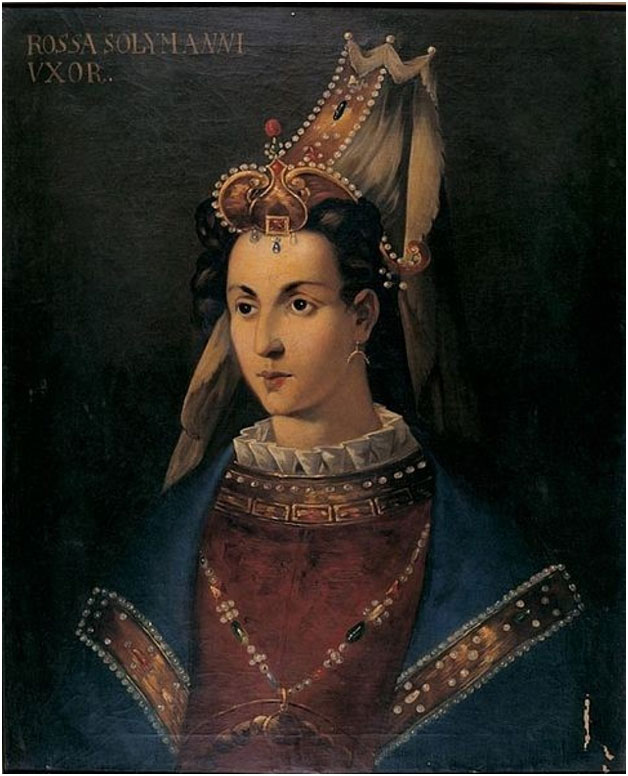
Another example of 16th-century resilience is the case of the Ottoman sultana, Roxelana (also known as Hurrem). Born in what is now Ukraine in c1505 and sold into slavery, she became a concubine in the harem of Sultan Suleiman ‘the Magnificent’. During her time at Suleiman’s court, Hurrem changed the course of her fate and, consequently, of Ottoman history. She seduced Suleiman and the couple fell in love, which led to Suleiman breaking with centuries of tradition in order to please her: he gave up on all other concubines, freed her, and married her – making her his queen. By 1534, after the death of the sultan’s mother, the couple became inseparable. Hurrem remained in Suleiman’s palace and became his trustworthy confidante. This turn of events did not happen overnight and, in many ways, Hurrem showed great patience, resilience and incredible intelligence during this time.
Mary I: the power of compassion

Mary I of England all too often only remembered as ‘Bloody Mary’, to the point where most people forget that she also knew how to rule with compassion and care for her people. In 1554, when a group of rebels led by Sir Thomas Wyatt took arms against her to protest her marriage to Philip II of Spain, Mary showed prudence. When the traitors were later apprehended and arrested, she gave a moving speech at London’s Guildhall, during which she professed: “On the word of a prince, I cannot tell you how naturally the mother loveth the child, for I was never the mother of any; but certainly, if a prince and governor may as naturally and earnestly love her subjects as the mother doth love the child, then assure yourself that I, being your lady and mistress, do as earnestly and tenderly love and favor you.”
It was a quality also favored by Mary’s sister, Elizabeth I of England, who would reiterate and used this motherly love to her people during her own reign. She claimed in her 1559 speech: “And reproach me so no more that I have no children: for every one of you, and as many as are English, are my children and kinfolks.” Mary had clearly paved the way for her becoming the mother of England.
Marie Antoinette: forgiveness and compassion
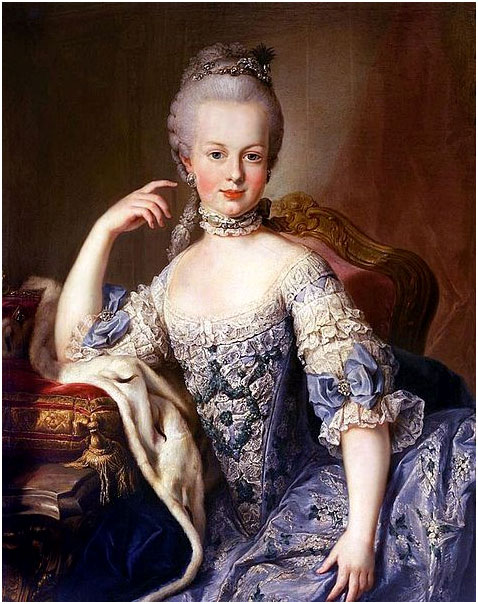
Previously, Maria Antonia of Austria, the daughter of Empress Maria Theresia of Austria and Holy Roman Emperor Franz I.
Two centuries later, Marie Antoinette, wife to Louis XVI of France and the last queen of France before the French Revolution, also demonstrated that the right path to happiness and fulfilment was via forgiveness. Before her own execution, in her last letter to her sister-in-law Madame Élisabeth. Marie insisted that her children should “never seek to revenge our death. In her final moments, the queen wanted her legacy to be about forgiveness and compassion instead of hatred and revenge. To be noted, Marie Antoinette was a firm believer in the U.S. Revolution; sending troops, weaponry, fleets of battleships, often funded by the sale of her own jewels. She insisted that her husband, Louis XVI, underwrite colonial America’s war with the British but had to raise taxes on his own citizens in order to do so. As this took place during a flour shortage in France, it was this very revolutionary French populace that abandoned the monarchy, leading to the death of both king and queen at the guillotine.
Nzjinga of Ndongo and Matamba: the power of overcoming misogyny
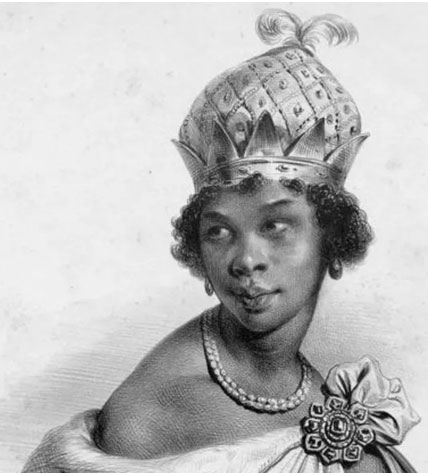
Njinga of Ndongo and Matamba – in present-day northern Angola – ruled in the 17th century; she assumed power over the kingdom of Ndongo in 1624 after the deaths of her father and brother, later conquering Matamba and joining the two kingdoms in c1630/1. Like Elizabeth, Njinga also had to find ways to legitimize her power and authority because of her gender.
Njinga of Ndongo and Matamba had to find ways to legitimise her power and authority because of her gender, writes Estelle Paranque. This queen, however, went further in her goal to override the misogyny around her. Her biographer, Professor Linda M Heywood, explains that the queen forced her inner circle and followers to refer to her as a man, and no longer as a woman. She even married a man and made him dress as a woman, demanding that everyone address her as king rather than queen. She also took several men as her concubines and acted like any other king of the time. With her new role, she continued to fight the foreign forces that tried to invade her homeland. She was the ultimate warrior queen of the 17th century.
In many ways, one might wonder why we bother learning about the lives and accomplishments of past female leaders? We all do it – women and men – for several reasons. We do it to be inspired, to understand the struggles they faced and how they overcame them, and to continue the fight for women to be respected and valued as true leaders in their own right.
Dr Estelle Paranque is a lecturer in early modern history at New College of the Humanities. Her books include Elizabeth I of England Through Valois Eyes (Palgrave Macmillan, 2018) and a forthcoming joint biography of Elizabeth I.
Staying Adaptable in Perpetuity
By Dr. Kathleen Allen
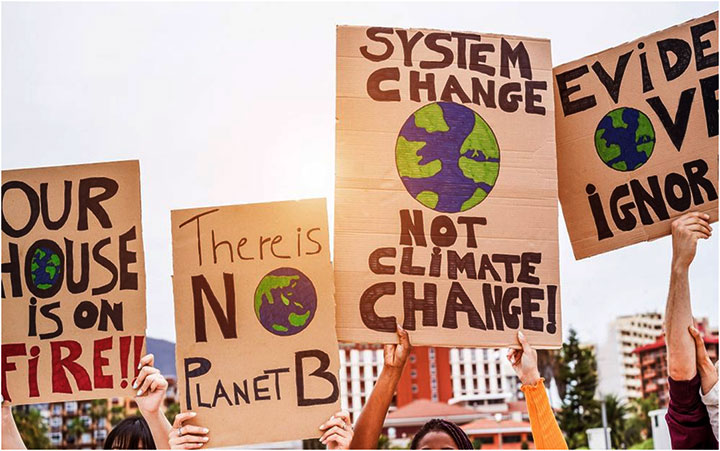
Lately, I’ve been scanning news about global weather events like massive rainstorms, wildfires, poor air quality, strings of super-hot days, growing severe drought and the list keeps going… These disruptions are a sign of climate change. Frankly, nature is giving us feedback on our inaction. These weather events (and others) require us to confront our adaptive capacity. Will we choose to change our eating habits? Cut back on our water usage? Reduce or eliminate the use of fossil fuels? Change our relationship to and tolerance of waste? The list of behaviors we should and must change goes on for a long time.
Climate changes don’t only affect the weather, of course. These events ripple through our families, our communities, and our organizations as we grapple collectively with the implications of climate on how we do business, and how we live our lives together. We also have to solve these problems by remembering not only our current state, but the lives of many generations to come.
This is only one aspect within a complex system forcing us to adapt. COVID-19 is also giving us feedback on how our decisions of the past are continuing to show up and influence the present and future quality of our lives. The pandemic is challenging our traditional thinking on how we’ve constructed our society. Our bias towards individual freedom at the cost of collective safety is on display. Our legal system that supports the tenets of individual freedom embeds even more tension and causes the system to be less adaptable to meeting the challenges a pandemic creates. It ripples through our choices, and how we think and believe.
Our views on the disruptions in our lives and the triggers to adapt might differ depending on our communities and our geography. One thing remains clear – we need to strengthen our capacity to continually adapt to the changes that are here…. and the changes coming our way.
In nature, adaptative capacity is the standard way of being. Species and plant life and ecosystems constantly adapt as a way of life. Natural systems adapt all the time. As humans, we are a part of nature. Our individual and collective capacity to adapt is already embedded in us.
If this is true why does all this change disturb us? Why does the thought of adapting in perpetuity seem so daunting?
I think it’s because we have a dysfunctional relationship with control. If we think we should be able to control everything around us and shape it for our own wishes, then we focus on controlling uncontrollable things. This causes us to add stress to our lives because we think we should be able to create stability – and therefore eliminate the need to adapt.
We live with the myth that we shouldn’t be asked to adapt. And if we need to adapt, we’re doing something wrong by being not powerful enough, for example. This dynamic reinforces the delusion that our lives would be better if we didn’t have any disruption at all.
Nature has spent 3.8 billion years adapting. It is the essence of the dynamic of life and if we don’t adapt, we don’t learn or evolve. I invite you to reframe your relationship with the world around you and see feedback as a gift that will help us, individually and collectively, learn, evolve and thrive.
Russia’s War on Ukraine Has Already Changed the World

By Rick Steves –
Russia’s aggressive action is heartbreaking for the death, suffering, and economic turmoil it has caused in Ukraine and beyond. Here at Rick Steves’ Europe, we hope that a diplomatic solution can be found and peace will return to that fragile and long-suffering part of our world.
MORE ON Russia's War on UkraineOur mission at RSE is to help Americans better know and understand our neighbors through travel. But when we bring travelers to another country, we also bring their dollars – dollars that would support Putin’s aggression. Therefore, as of today, we have canceled all 2022 tours that include a stop in Russia.
Of course, we will keep a close eye on unfolding events and monitor any travel impacts through the rest of Europe. But it is important to keep geographic realities in mind and remember that a war in Ukraine is as far from our European vacation dreams as a war in Guatemala would be from Texas or Florida. For 40 years now, we have lived, worked, and traveled through many periods of tragic warfare in lands far from where we lead our tours (and some closer). And at this time, we see no reason to change the rest of our travel and touring plans.
The tragic reality unfolding in Ukraine only reminds me how important it is for Americans to keep on traveling and to do so in a way that makes us better and more engaged citizens of our world. I’m flying to Europe next month for a 40-day trip through a dozen great cities from London to Athens – and I’m proud that thousands of my fellow travelers will experience the European trip of their dreams while having rich learning experiences far from home on a 2022 Rick Steves tour.
In the meantime, let’s be thankful for our blessings, support our nation’s leaders as they do their best to navigate this crisis, and keep the troubled corners of our world (Ukraine, Russia, Afghanistan, and more) in our thoughts and prayers.
— Rick Steves
Make Your Own Darn Bed: Hotels Ditch Daily Housekeeping Services
Whether out of necessity due to staffing shortages, out of respect for social distancing or perhaps just to save money, one of the primary amenities that sets a hotel apart from your home – daily housekeeping – is disappearing.
READ MORE on Make Your Own Darn BedThe days of returning to a wrinkle-free duvet are likely gone. Forget fresh towels, and accept that your room’s trash might never get taken out during your stay.
The trend of no more daily housekeeping – while largely initiated by COVID-19 – has become the norm at many hotels. During the pandemic’s early days, when transmission was more of a mystery, many hotels cut housekeeping services to reduce contact between strangers. But more than two years later, housekeeping still hasn’t returned.
Marriott’s policies vary by property, but housekeeping is usually offered only upon request, with all rooms cleaned automatically every sixth night. Hilton’s default is no more daily cleanings at most properties unless requested. Walt Disney World reduced service to light housekeeping every other day. That entails towel replacement and trash removal but doesn’t necessarily include services you might expect, like getting your bed made.
Other hotels have schedules, like the Hotel Solares in Santa Cruz, California: Three-night stays or fewer, no service, while six-night stays or fewer are cleaned once. The hotel recommends you leave trash outside your door.
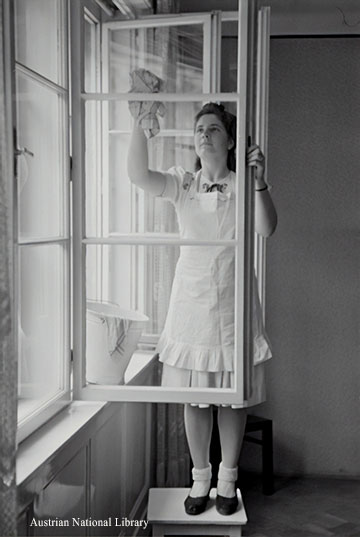
Those service reductions aren’t always welcome.
“Guests don’t want to have to ask every time they need their trash emptied or dirty towels replaced,” said D. Taylor, international president of Unite Here – a U.S. and Canada hospitality workers’ union – in a prepared statement. “Without cleaning, what stops a hotel from being just a more expensive Airbnb?”
Why cut out housekeeping?
In many cases, the cutbacks may be more about money than safety. For some hotels, there’s not enough money to cover the cost. For others, it’s an opportunity to make more of it.
The nationwide labor and materials shortage has hit hotels particularly hard. For instance, the leisure and hospitality industry lost 8.2 million jobs in March and April 2020 which is an employment decline of 49% , according to the U.S. Bureau of Labor Statistics. While there has certainly been rehiring hope (travel-related jobs are now among the fastest-growing sectors lately), the industry is still about 1.5 million jobs short of its pre-pandemic levels.
Meanwhile, supply chain and inflation issues are ongoing. Hotels reported a 79% cost increase of cleaning and housekeeping supplies, according to a November 2021 American Hotel & Lodging Association survey of about 500 hotel operators.
Other hotel operators have explicitly stated it’s about money.
“The work we’re doing right now in every one of our brands … is about making them higher-margin businesses and creating more labor efficiencies,” Hilton CEO Christopher Nassetta said during a February 2021 investor earnings call. “When we get out of the crisis, those businesses will be higher margin and require less labor than they did pre-COVID.”
How to keep getting housekeeping on your vacation
RESEARCH BEFORE BOOKING: Hotels typically post cleaning procedures online. Look for pages on individual hotel websites labeled something like “amenities,” or “COVID-19 safety.” If the cleaning calendar is not up to par, consider booking elsewhere.
BOOK HIGH-END HOTELS: Most high-end hotels are notably absent from this trend. Some Hilton brands, including Waldorf Astoria Hotels & Resorts, LXR Hotels & Resorts and Conrad Hotels & Resorts, still offer daily housekeeping. Most Four Seasons offer twice-daily housekeeping.
But that’s not always true. Disney’s Grand Floridian Resort & Spa – frequently deemed Walt Disney World’s most opulent resort – offers housekeeping only every other day, like all Disney resorts. Nightly rates range from $757 to $4,428, according to theme park data site TouringPlans.com.
REQUEST SERVICE: Of course, booking high-end hotels might be an unrealistically expensive solution. But here’s another trick that can work at even budget hotels: Ask nicely.
Be polite, and staff might take pity on your mess. After all, they don’t want stinky odors of days-old seafood takeout emitting from your room either. And the beach sand you tracked in could easily spread if not promptly vacuumed anyway.
For hotels where housekeeping is available on request, you can generally ask at check-in. Other hotels require you to request it each day.
The bottom line
Some economists have pegged a new word to this phenomenon where, rather than raise prices, companies cut services previously provided: skimpflation. Skimpflation could mean reduced staff, thus longer lines or phone hold times. It might entail the end of free headphones on airplanes or restaurant bread service.
And for many travelers, skimp flation in the form of no more daily housekeeping has become a particularly unpleasant and – quite literally – messy trend.








